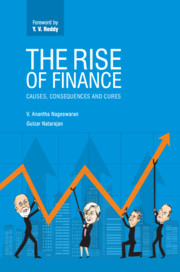2 - The Rise of Finance: Origins
from Part A - The Causes
Published online by Cambridge University Press: 02 May 2019
Summary
This chapter begins by establishing a common understanding of financialization in Section 2.1. In Section 2.2, it underscores the important point that is often missed in the discourse on reining in finance. Its rise was part of the neoliberal agenda that began to be assembled in the 1980s. Section 2.3 traces the rise and growth of financialization in the twentieth century to the onset of economic stagflation in the 1970s in much of the developed world. That propelled many forces that have dominated and shaped the world economy in unforeseen ways. Globalization of trade and financialization are two important forces that the economic troubles of the 1970s spawned. In Section 2.4, we show that deregulation propelled and strengthened financialization and made it inexorable even though finance is far less amenable to the free and untrammelled play of market forces compared to other economic activities. In Section 2.5, we establish that financialization went global, thanks to the hegemony of the US dollar and the dependence of the rest of the world on American economic growth.
What is financialization?
The most comprehensive analysis or a more formal treatment of financialization comes from Thomas Palley. For him, financialization is ‘a process whereby financial markets, financial institutions, and financial elites gain greater influence over economic policy and economic outcomes’. He identifies three principal impacts – elevation of the significance of financial sector relative to the real sector, transfer of income from the real sector to the financial sector and increase in income inequality and contribution to wage stagnation. He also points to three different conduits – changes in the structure and operation of financial markets, behaviours of non-financial corporations and economic policy.
Donald Tomaskovic-Devey and Ken-Hou Lin of the University of Massachusetts in Amherst (the alma mater of one of us) go one step further than Palley. They define financialization as consisting of two interdependent processes: the increasing importance of financial services firms to the American society in economic, political and social terms and the increased involvement of non-financial firms in financial activity. So, they view financialization as a process that placed financial services firms at the centre of American society and not just at the centre of the American economy. We lean towards this formulation. Financialization not only influenced the economy but also had social consequences through its impact on wages and compensation.
- Type
- Chapter
- Information
- The Rise of FinanceCauses, Consequences and Cures, pp. 18 - 50Publisher: Cambridge University PressPrint publication year: 2019



